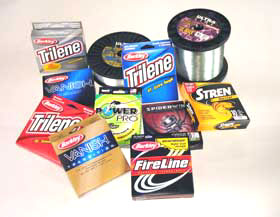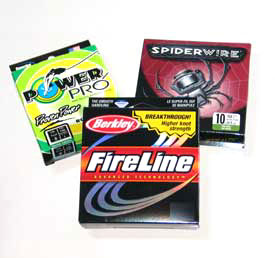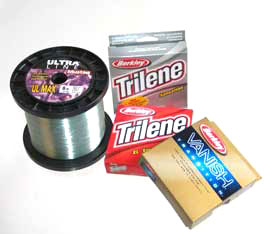 Sometimes you see things that simply boggle the mind; the guy that forks out a small fortune on a set of shiny new chrome rims only to mount them on a rust-bucket, or the guy that buys an $800.00 golf bag and fills it with a cheap set of clubs. A while back I was cruising the isles of one of my favorite tackle “super-stores” and witnessed something that sent my head reeling.
Sometimes you see things that simply boggle the mind; the guy that forks out a small fortune on a set of shiny new chrome rims only to mount them on a rust-bucket, or the guy that buys an $800.00 golf bag and fills it with a cheap set of clubs. A while back I was cruising the isles of one of my favorite tackle “super-stores” and witnessed something that sent my head reeling.
A well dressed gentleman was in the process of purchasing a pair of rather high priced, top-of-the-line rod and reel outfits. He was explaining to the young store clerk that he was preparing to head out on a “walleye fishing trip of a lifetime” and wanted to be rigged up right for the event. The part that really caught my attention was when the man was asked if he needed some fishing line to spool up those new reels. “Oh, just spool them up with whatever’s the cheapest stuff you have.” He said, “I’ve already spent enough today.” I must have looked pretty dumbfounded standing there with my jaw on the ground. This guy had just dropped close to four C-notes on two rod and reel combos, not to mention what I’m sure this upcoming angling adventure was going to cost him, and he was worried about saving a few bucks on fishing line! Luckily for him, the young man behind the counter took his job seriously and persuaded him to go with a more appropriate choice of line for his newly acquired gear, pointing out that he’d hate to have his “trip-of-a-lifetime” be spoiled by losing a great fish to an inferior string.
As I picked my jaw up off the floor and breathed a sigh of relief, I began to wonder just how many poor saps had ruined their chance at that “fish-of-a-lifetime” because they chose to save a few bucks or were simply uninformed as to the importance of picking the right line for their fishing techniques. It’s easy to understand how one could get confused these days. Where there used to be just a handful of monofilament line choices for anglers, there’s now literally dozens … and not just mono, but also braids, co-polymers, fluorocarbons … the selection is incredible.
So where does one begin when looking for the right line? Is there one line that will do it all? The answers: First, start by understanding the techniques you’re using to catch the fish, and Second, “No”, frankly one line won’t cut it. Walleyes are highly adaptable fish, and thus walleye anglers use a wide variety of presentations in pursuit of these fish. From big water trolling, to ultra finesse rigging, each tactic presents its own criteria when it comes to line choice.
 Let’s start with the most basic of presentations, jigging. It’s an intimate technique incorporating finesse, stealth and sensitivity. The angler needs to feel the jig to know it’s in the strike zone as well as the bite, which can often be quite subtle. Choosing the right line for jigging depends a lot on your level of fishing experience. For the “novice” angler, one that has yet to develop the “feel” of a more experienced angler, lines in the category of “braided lines” are a good choice. These high-tech, synthetic fiber lines like Berkley FireLine, SpiderWire Stealth and Power Pro, feature a small diameter (compared to equivalent pound test monofilament lines), and virtually no stretch, making them extremely sensitive and able to telegraph "feel" better than most other lines. Beginners often lament as to whether they are actually feeling a bite, the bottom or possibly debris and hesitate as to whether they should set the hook, or not. A braid type line can compensate for this hesitation, resulting in more hooked fish.
Let’s start with the most basic of presentations, jigging. It’s an intimate technique incorporating finesse, stealth and sensitivity. The angler needs to feel the jig to know it’s in the strike zone as well as the bite, which can often be quite subtle. Choosing the right line for jigging depends a lot on your level of fishing experience. For the “novice” angler, one that has yet to develop the “feel” of a more experienced angler, lines in the category of “braided lines” are a good choice. These high-tech, synthetic fiber lines like Berkley FireLine, SpiderWire Stealth and Power Pro, feature a small diameter (compared to equivalent pound test monofilament lines), and virtually no stretch, making them extremely sensitive and able to telegraph "feel" better than most other lines. Beginners often lament as to whether they are actually feeling a bite, the bottom or possibly debris and hesitate as to whether they should set the hook, or not. A braid type line can compensate for this hesitation, resulting in more hooked fish.
For the more experienced jig fishermen, there’s a group of lines best described as “refined monofilaments”. Berkley’s Trilene Sensation, Stren Magnathin and SpiderLine Super Mono fall in to this group. These lines tend to be smaller in diameter than standard monofilaments, but with greater strength and less stretch. Most “feel” is retained, like with braids, however, there is some stretch so jigs are not so easily pulled away from fish with quick hook sets.
The most popular line size for jigging is typically six pound test. However, four pound test may be called for in ultra-finesse situations. On the other end of the spectrum, eight or even ten pound test may be the right choice if you’re dealing with heavy snag infested waters.
Another low-stretch line category that is especially good in ultra-clear water is the fluorocarbons. Berkley Vanish, Vanish Transition, P-Line Fluorocarbon, and Seaguar are all great examples. Fluorocarbon lines have a light index very similar to that of water, making them virtually “invisible under water”. The Vanish Transition features a unique characteristic in that it takes on a highly visible "gold" color above the water, making it easy for the angler to see the line and visually detect bites that may otherwise go unnoticed.
 Another popular walleye technique is trolling. While “feel” is not nearly as critical here, line choice still plays a key role in your presentation’s effectiveness. Consider that when trolling crankbaits for instance, you’re typically running long lengths of line out behind the boat. That means that once a fish is hooked, it’s reeled in a great distance. If you’re dealing with big fish, as often is the case when trolling big water in The Great Lakes, the chances of losing that fish increase with every second spent reeling it in. A fishing line with a good amount “stretch” to it can act as a “shock absorber” taking the brunt of hard runs and surging head shakes over the course of a long battle.
Another popular walleye technique is trolling. While “feel” is not nearly as critical here, line choice still plays a key role in your presentation’s effectiveness. Consider that when trolling crankbaits for instance, you’re typically running long lengths of line out behind the boat. That means that once a fish is hooked, it’s reeled in a great distance. If you’re dealing with big fish, as often is the case when trolling big water in The Great Lakes, the chances of losing that fish increase with every second spent reeling it in. A fishing line with a good amount “stretch” to it can act as a “shock absorber” taking the brunt of hard runs and surging head shakes over the course of a long battle.
Also consider what kind of wear and tear your trolling line is liable to go through in a day on the water. The use of clip-on apparatuses such as planer boards, downrigger releases, and Snap Weights, not to mention the hazardous environment trolling lines often get drug through (rocks, timber, Zebra Muscles) can wear on your line, so it makes sense that a line with a high abrasion resistance would be essential. Berkley Trilene XT, Trilene Sensation, Stren DuraTuf, and Mustad’s Thor Ultra Line all fall into this category. Here too, fluorocarbons come in to play when dealing with very clear water and spooky walleyes.
Ten pound test is by far the most used size for most walleye trolling applications. In fact, when the book Precision Trolling was released, they used ten pound test Trilene XT as their standard line for determining running depth of all the crankbaits they tested. However, when the need arises to run baits deeper than they will typically go on ten pound test monofilament, you do have a few options. You can go with a smaller size mono, or you can switch to a “braid” such as FireLine in ten pound test. It’s smaller diameter (ten pound test FireLine has a diameter comparable to four pound test mono) can help you get as much as thirty percent more running depth from a bait with the same amount of line out.
Of course there are a ton of other great fishing lines out there, and each may have a place in your arsenal of walleye fishing techniques. Lines like Berkley Trilene XL or Mustad’s Ultra Line UL Max are very limp, low-memory lines that, in eight to twelve pound test, work great in casting situation. Then there’s the category of fluorocarbon leader materials (generally stiffer than fluorocarbon fishing line) that work great for tying up spinners and rigging snells. The key to choosing the right lines for your walleye fishing is to select those that fit the presentations you fish. Line should never be an after-thought. It’s the critical link between you and that “fish of a lifetime”. Don’t settle for “what ever’s the cheapest” … choose wisely, and land that big’n.










